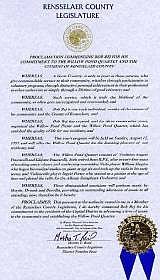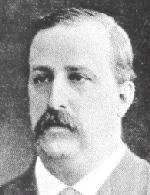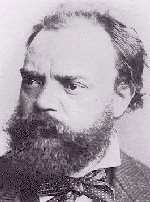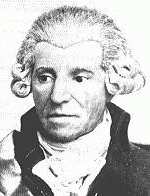
|
Willow
Pond Quartet Concert Program 1997 |
Sunday, 17 August 1997 at 3:00 p.m. Mozart:
String Quartet Nr. 3 in G, K. 156 Beethoven:
String Quartet in B-flat Op. 18, No. 6 Mendelssohn:
String Quartet in E Op. 81 (unfinished) Borodin:
String Quartet Nr. 2 in D Dvorák:
String Quartet Nr. 10 in E-flat Op 51 Haydn:
String Quartet in d, Op 76 Nr. 2 "Quinten"
Angelo Frascarelli
(Violin) |
|
|
Mozart: String Quartet Nr. 3 in G, K. 156 Wolfgang Theophilus (Amadeus - a middle name that the composer himself used only in jest) Mozart was born in Salzburg, 27 January 1756. He showed musical gifts at an early age; composing when he was five and, when he was six, playing before the Bavarian elector and the Austrian empress. In mid-1763 the Mozart family set out on a tour that took the young Wolfgang to Paris and London, visiting numerous courts en route. Mozart astonished his audiences with his precocious skills; he played to the French and English royal families, had his first music published, and wrote his earliest symphonies. The family arrived home late in 1766; but soon they were off again, to Vienna, where hopes of having an opera by Mozart performed were frustrated by intrigues. The Archbishop of Salzburg made Wolfgang Konzertmeister, with salary, however, his father wished him to enjoy study in Italy. His concerts there were sensations. The Pope gave him the Order of the Golden Spur and Mozart even signed some his compositions by his new title Signor Cavaliere Amadeo. This afternoon we hear a product of Mozart’s stay in Italy, the last movement (Tempo di Menuetto) of his Quartet in G, composed in 1772 while the sixteen-year-old was living in Milan.
Beethoven: String Quartet in B-flat Op. 18, No. 6 In his first set of string quartets – the six of Opus 18 – we hear Beethoven composing much in the style of his teacher Haydn, yet still flexing his muscles as he begins to sense the power that would soon enable him to break down the doors of 18th century conventions. The six quartets were composed over the period from 1798 to 1800 and are dedicated to Prince von Lobkowitz who, at about the same time, also commissioned Haydn to write what would be that composer’s last quartets. The B-flat quartet is in many ways the most forward looking of the Opus 18 group and the scherzo takes us into uncharted waters of rhythmic adventure. Contrast it with Haydn’s Quinten Quartet, composed only three years earlier, which concludes today’s program.
Mendelssohn: String Quartet in E Op. 81 (unfinished) Felix Mendelssohn-Bartholdy was born in Hamburg on 3 February 1809 of a distinguished intellectual, artistic, and banking family, he grew up in a privileged environment. With its emphasis on clarity and adherence to classical ideals, Mendelssohn's music shows alike the influences of Bach (fugal technique), Handel (rhythms, harmonic progressions), Mozart (dramatic characterization, forms, textures) and Beethoven (instrumental technique). Yet he developed a characteristic style of his own, often underpinned by a literary, artistic historical, geographical or emotional connection; indeed it was chiefly in his skilful use of extra-musical stimuli that he was a Romantic. Less dependent on programmatic elements his chamber music, especially some of the string quartets, the Octet, and the two late piano trios, beautifully reconcile classical principles with personal feeling and are among his most striking compositions.
Borodin: String Quartet Nr. 2 in D
Alexander Porfir’evich Borodin was born 12 November 1833, an illegitimate son of a Georgian prince (Luka Stephanovich Gedianishvili) and Avdot’ia Antonova, the wife of an army physician. He received his family name and patronymic from Gedianishvili’s valet, Porfirii Ionovich Borodin whose wife was listed in the birth registry as Alexander’s mother. Alexander was raised by his natural mother – always referred to as "Auntie" - in St. Petersburg. He learned to play the flute, and grew fond of the western classics and especially the music of Beethoven. At age nine he composed a piano duet in d "Helene". From 1850 to 1856 he attended the St. Petersburg Academy of Medicine and in 1858 defended his thesis "On the Analogy of Arsenic Acid with Phosphoric Acid in Chemical and Toxicological Behavior." Although trained as both a physician and chemist, it was the latter career that he pursued and from 1858 to 1862 he received postdoctoral training in Italy, Germany, Switzerland and France, sometime accompanied in his travels by Dmitri Mendeleev (of periodic table fame). He was a member of the Russian delegation at the 1st International Chemical Congress in Karlsruhe in 1860. In 1862, Borodin was appointed assistant professor at his alma mater and two years later to professor which would be his lifelong career; he also acted as vice-chancellor for many years. As an administrator, Borodin also led the establishment of a Medical School for Women. Although, Russia had seen a women's equality movement during the 1860s, the government limited the scientific education of women to obstetrics. With help from fellow professors, Borodin's laboratory in the St. Petersburg Academy of Medicine was the first Russian laboratory to open its doors to women. His research included
study of the reactions of organic halogens, condensation of aldehydes,
hydroamines, nitrosoamarine, synthesis of disinfectants, and the analysis
of tea and Bukhara opium. In 1876 he developed an azotometric procedure
for the quantitative determination of urea in body fluids that was
widely used in clinical chemistry laboratories: A continual lifelong conflict for Borodin was caused by the competition for his time between musical and scientific activities. Nonetheless he is regarded as one of the most prominent Russian composers of the mid-19th century. He was one of the so-called "Mighty Handful" or "Mighty Five" (other members were: Balakirev, Cui, Moussorgsky, and Rimsky-Korsakov). These composers sought to write true Russian music and attempted to generate a national school of Russian music. Nobody less than Franz Liszt was one of the first to recognize the merits of his First Symphony, which took Borodin five years to write. His Second Symphony used up seven years of the composer's time. This caused his friends to present him with a tortoise-shaped ashtray. His output includes three symphonies, a piano quintet, two string quartets, songs, and the opera Prince Igor. Borodin started composition of his second string quartet in the summer or 1881 and, uncharacteristically, completed it in a few weeks. It is dedicated to his wife and is permeated with romantic languor. It’s third movement Nocturne is probably Borodin’s best known music. The Scherzo that we hear this afternoon opens with a great deal of activity followed by a waltz theme of great elegance. The great popularity of Borodin’s themes is due in large part to their free adaptation in the popular musical Kismet by Robert Wright and George Forrest. Much of Borodin’s music has an "oriental" or "Islamic" quality that lent itself to this adaptation. Kismet premiered in 1953 in New York where it continued for 583 performances and opened even more successfully in London where it ran for 648 performances. It attracted further attention as the 1955 MGM motion picture directed by Vincente Minnelli and staring Dolores Gray as Lalume and Vic Damone as the Caliph. Since these notes were prepared this interesting webpage appeared: Alexandr Borodin, Professional organic chemist and Amateur Composer.
Dvorák: String Quartet Nr. 10 in E-flat Op 51
Haydn: String Quartet in d, Op 76 Nr. 2 "Quinten"
Although he frequently regretted the burdens of his job and the isolation of Esterháza, Haydn's position was enviable by 18th century standards. One remarkable aspect of his contract after 1779 was the freedom to sell his music to publishers and to accept commissions. As a result, much of Haydn's work in the 1780s reached beyond the guests at Esterháza to a far wider audience, and his fame spread accordingly. Haydn was prolific in nearly all genres, vocal and instrumental, sacred and secular. Haydn's productivity is matched by his inexhaustible originality. More than one hundred symphonies and almost eighty string quartets that span his career document a growth from the easy elegance suitable for the home music making to the public virtuosity of his late works. His contemporaries admired his innovative manner of turning a simple tune or motive into unexpectedly complex developments. Dramatic surprise, often turned to humorous effect, is characteristic of his style, as is a fondness for folk-like melodies. Haydn's final set of six string quartets (op 76) were written after the Esterháza Court Orchestra was disbanded and the composer was living in Vienna. These quartets were commissioned by Count Erdödy and show the ever-creative Haydn striking out in new directions. The second of this set, in D-minor, begins with a sequence of falling fifths that permeates the first movement and gives the piece its alternative title, Quintenquartett ("Fifths" Quartet). Despite this name, it is the interval of the octave that provides the central musical argument of the Menuetto. The unusually harsh sound of the open octaves has resulted in references to this movement as the "Witches’ Canon." |
|
| [Back to Willow Pond Concert Page] |
 Ask
the man or woman in the street if he or she is familiar with Alexander
Borodin’s Price Igor, his two string quartets, his symphonies,
or his In the Steppes of Central Asia and you are apt to get
an uncomprehending stare. Ask the same person whether they have heard
Ask
the man or woman in the street if he or she is familiar with Alexander
Borodin’s Price Igor, his two string quartets, his symphonies,
or his In the Steppes of Central Asia and you are apt to get
an uncomprehending stare. Ask the same person whether they have heard
 Antonín
Dvorák was born in a small village on the banks of the river
Vltava, north of Prague in 1841. He left school aged eleven to become
an apprentice butcher, and the following year was sent to Zlonice
to learn German. However, he spent much of his time on music lessons,
learning the organ, viola, piano and basic composition. His interest
in music was such that, despite misgivings, his father eventually
allowed him to enroll at the Prague Organ School in 1857. There Dvorák
received the strict training of a church musician, but after classes
attended as many orchestral concerts as he could, enjoying especially
the music of contemporary composers such as Wagner and Schumann. After
graduating in 1859, Dvorák became principal violist in the
new Czech Theater orchestra, conducted after 1866 by Smetana. The
need to supplement his income by teaching left Dvorák with
limited free time, and in 1871 he gave up the orchestra in order to
compose. In 1874 Dvorák entered no fewer than fifteen works
- including his Third Symphony - for the Austrian National Prize.
He won and received a welcome cash prize and, perhaps more importantly,
the admiration and support of Brahms, who was one of the judges. From
this point on Dvorák 's fame escalated. The Tenth Quartet in
E-flat was completed in early 1879 and is one of the composers most
frequently performed string quartets, due in some part to the typically
Dvorákian dumka movement – alternately dreamy and joyously
exuberant - that we hear this afternoon.
Antonín
Dvorák was born in a small village on the banks of the river
Vltava, north of Prague in 1841. He left school aged eleven to become
an apprentice butcher, and the following year was sent to Zlonice
to learn German. However, he spent much of his time on music lessons,
learning the organ, viola, piano and basic composition. His interest
in music was such that, despite misgivings, his father eventually
allowed him to enroll at the Prague Organ School in 1857. There Dvorák
received the strict training of a church musician, but after classes
attended as many orchestral concerts as he could, enjoying especially
the music of contemporary composers such as Wagner and Schumann. After
graduating in 1859, Dvorák became principal violist in the
new Czech Theater orchestra, conducted after 1866 by Smetana. The
need to supplement his income by teaching left Dvorák with
limited free time, and in 1871 he gave up the orchestra in order to
compose. In 1874 Dvorák entered no fewer than fifteen works
- including his Third Symphony - for the Austrian National Prize.
He won and received a welcome cash prize and, perhaps more importantly,
the admiration and support of Brahms, who was one of the judges. From
this point on Dvorák 's fame escalated. The Tenth Quartet in
E-flat was completed in early 1879 and is one of the composers most
frequently performed string quartets, due in some part to the typically
Dvorákian dumka movement – alternately dreamy and joyously
exuberant - that we hear this afternoon.
 Of
humble origins, Franz Joseph Haydn was born in Rohrau, near Vienna,
on 31 March 1732. When eight years old he was accepted into the choir
school of Saint Stephen's Cathedral in Vienna, where he received his
only formal education. Dismissed from the choir at the age of seventeen,
when his voice broke, he spent the next several years as a struggling
freelance musician. In 1755 Haydn was engaged briefly by Baron Karl
Josef von Fürnberg, for whom he apparently composed his first
string quartets. Haydn's marriage in 1760 to Maria Anna Keller proved
to be unhappy. The turning point in Haydn's fortunes came in 1761,
when he was appointed assistant music director to Prince Pál
Antal Esterházy; a year later he became full director. As Kapellmeister,
Haydn served under the patronage of three successive princes of the
Esterházy family. The second of these, Pál Antal's brother,
Prince Miklós József Esterházy, was an ardent,
cultivated music lover who could boast a musical establishment second
to none, the management of which made immense demands on its director.
Of
humble origins, Franz Joseph Haydn was born in Rohrau, near Vienna,
on 31 March 1732. When eight years old he was accepted into the choir
school of Saint Stephen's Cathedral in Vienna, where he received his
only formal education. Dismissed from the choir at the age of seventeen,
when his voice broke, he spent the next several years as a struggling
freelance musician. In 1755 Haydn was engaged briefly by Baron Karl
Josef von Fürnberg, for whom he apparently composed his first
string quartets. Haydn's marriage in 1760 to Maria Anna Keller proved
to be unhappy. The turning point in Haydn's fortunes came in 1761,
when he was appointed assistant music director to Prince Pál
Antal Esterházy; a year later he became full director. As Kapellmeister,
Haydn served under the patronage of three successive princes of the
Esterházy family. The second of these, Pál Antal's brother,
Prince Miklós József Esterházy, was an ardent,
cultivated music lover who could boast a musical establishment second
to none, the management of which made immense demands on its director.